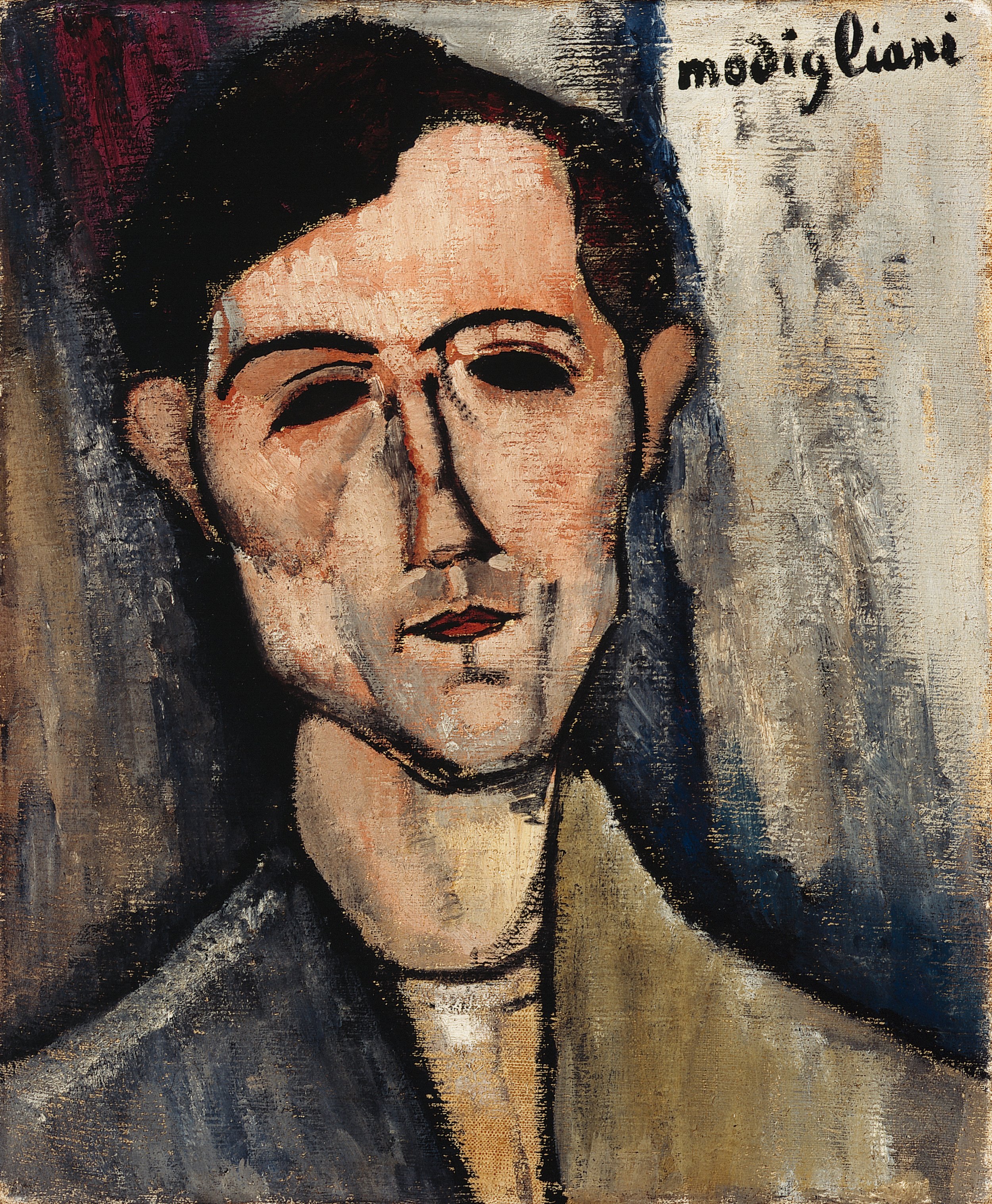Spotlight
In Spotlight, we will periodically present short essays on the latest research findings and overlooked aspects of Modigliani’s life and circle. While the artist’s name is readily recognized, and volumes of literature have been written about him and his work, there remains a surprising number of overlooked areas in his biography. This is particularly true of some of his subjects and early collectors of his work, many of whom were marginalized over time because of their gender or by anti-Semitic forces that culminated with World War II. Spotlight will focus on these individuals—the models, collectors, friends, and lesser-known art dealers in Modigliani’s circle—whose stories enrich the provenance of his works and, at the same time, contribute to the scholarship on the artist.
Gabrielle Soëne
Elle est très très belle…
– Blaise Cendrars
An elegant young woman with a distinctive hairstyle is recognizable in Modigliani’s oeuvre thanks to a half-dozen known pencil drawings and, presumably, one canvas that feature her likeness. Two of the drawings are helpfully inscribed with her name: “Gaby” and “Gaby Soene.” With this latter detail we can identify Gabrielle Soëne (1888–1943) as the artist’s captivating model. Soëne was the daughter of a weaver and the eldest of eight children. A skilled seamstress, she was an aspiring modiste who, by 1913, had resolutely moved to Paris from Tourcoing, in Northern France, a city close to the Belgian border. She is but one of many aspiring female artists drawn to the French capital before the war.
Renée Modot
Hiding in Plain Sight: Renée Modot
The model is the wife of a French moving picture actor. She is known as “Mado” [sic].
This annotation appears on the original inventory record for “Nude on a Divan,” a painting dated 1918 in the Chester Dale Collection at the National Gallery of Art, Washington, D.C. A further note specifies that the work was painted in Nice. Despite these intriguing clues, until now the alluring model in the painting has never been positively identified. New archival research reveals that she was Renée Modot (1894–1978), wife of the French film actor Gaston Modot (1887–1970).
Game Changer
How Galerie Bernheim-Jeune Initiated the Modigliani Craze
One of the leading art galleries in Paris, Galerie Bernheim-Jeune first entered the Modigliani market in September 1920. Just months after the artist’s death, the gallery acquired seven paintings from the Norwegian art dealer Walther Halvorsen (1887–1972). By year’s end, Bernheim-Jeune had purchased five more paintings from a range of sources, including one of Amedeo Modigliani’s earliest collectors, as well as one of his good friends. Even the art dealer Paul Guillaume (1891–1934), one of the first to support the artist, sold a painting to Galerie Bernheim-Jeune in December 1920.
Fernand Thibaut
A Case Study in Provenance Research
Provenance research can lead to serendipitous discoveries. This is particularly true when researching the owners of Modigliani’s portraits because of the interconnectedness of the artistic community living and working in close proximity in Paris in the years leading up to and during the First World War. Many of Modigliani’s friends and associates were not only his models but some were among his earliest collectors.
“Première Exposition,” Lyre et Palette, November 19 – December 5, 1916
“Première Exposition,” Lyre et Palette
November 19 – December 5, 1916
Against the backdrop of Erik Satie’s performance of a “musical moment,” notable literary and artistic personalities mingled with the picturesque crowd of Montparnasse artists and models before the bold canvases at the “Première Exposition” vernissage at Lyre et Palette. The group show featured work by such recognized artists as Henri Matisse and Pablo Picasso, as well as Manuel Ortiz de Zarate and Moïse Kisling. Modigliani, however, was by far the most prominently represented, with fourteen paintings and a group of drawings.
“Peintres d’aujourd’hui”
Modigliani at the Galerie Paul Guillaume
The poet Max Jacob introduced Paul Guillaume to Modigliani probably in late 1914. Guillaume then became the artist’s primary dealer and took credit for Modigliani’s shift from sculpture to painting. The artist duly produced four portraits of his new agent, three of which are dated on the front: 1915, September 1915, and 1916, roughly documenting the period of their alliance. Curiously, though he acquired a substantial number of paintings from the artist during this time, Guillaume never organized a solo exhibition for Modigliani.
Modigliani’s First Solo Exhibition
There was a lot at stake for the poet-turned-art-dealer Léopold Zborowski. He had represented Modigliani for about a year―paying him a stipend and supplying him with materials and models―despite having little success in selling the works. Without a gallery of his own, Zborowski convinced Berthe Weill to host Modigliani’s first solo show at Galerie B. Weill in December 1917. Ultimately, this would be the artist’s only lifetime solo exhibition.
How Do You Solve a Problem Like Modigliani?
A persistent problem continues to surround the legacy of Amedeo Modigliani, one that emerged soon after his untimely death in January of 1920 at the age of 35. The ensuing acceleration in demand for the artist’s paintings was almost immediately met with a steady influx of forgeries, highlighting the necessity of a formal catalogue of Modigliani’s complete body of work. No less than five different versions have been produced, but none so far has satisfactorily resolved the extent of the artist’s oeuvre.
Modigliani on the Move
David M. Challis
Analysing the geographical location of the 156 oil paintings recorded by Ambrogio Ceroni in his 1958 catalogue raisonné gives unexpected insights into the movement and increasingly favourable reception of Modigliani’s oeuvre in the first half of the twentieth century. While Ceroni’s work has been critiqued for its inaccuracies and omissions, the paintings recorded in the catalogue provide a solid case study for understanding where the vast majority of Modigliani’s work was located in 1958. The catalogue shows that in the thirty-eight-year period since the artist’s death in 1920, more than half of his recorded oil paintings had departed from their point of origin in France. These paintings were now located in art collections across a remarkably diverse range of countries, including the United States of America, Italy, Switzerland, the United Kingdom, Germany, Canada, Brazil, and Argentina
Marie Beerbohm
A Thoroughly Modern Woman
“Mr. Edward Wolfe thinks this may be Marie Beerbohm, niece of Max Beerbohm.”
This handwritten addendum appears at the bottom of the original typed record for “Woman with Red Hair,” a painting dated 1917 in the Chester Dale Collection at the National Gallery of Art, Washington, D.C. Mary Bullard, the inscription’s likely author, was Maud Dale’s long-time assistant who kept meticulous records of the rapidly growing art collection. The Dales purchased the painting in March 1928 and when it was shown three years later the title was given as “Portrait, Mlle. P. de C.” Edward Wolfe may have been trying to set the record straight; having known Marie well, he was in a position to identify her.
Osbert and Sacheverell Sitwell - 2
The Peasant Girl of Carlyle Square
In advance of the August 1919 opening of French Art 1914–19, at the Mansard Gallery, London, Sacheverell and Osbert Sitwell, the exhibition’s organizers, were invited by Léopold Zborowski to purchase at cost a Modigliani painting of their choosing. They selected a work that Osbert later referred to as the “Peasant Girl” for the modest sum of four pounds. This was a very good price considering that earlier that year Modigliani’s “Portrait de Dédie,” 1918, sold for the equivalent of twenty-two pounds in the sale of the Eugène Descaves collection at the Hôtel Drouot in Paris.
Osbert and Sacheverell Sitwell
The Missed Opportunity
The offer was made sometime in the late fall or early winter of 1919: “Twelve large nudes, sixty to eighty paintings, and many sculptures and drawings” for between £700 and £1,000. Léopold Zborowski (1889–1932), the Polish poet-turned-art dealer who had represented Modigliani for the past three years, was probably desperate. With the artist’s health failing, he turned to the aristocratic English brothers, Osbert (1892–1969) and Sacheverell Sitwell (1897–1988), offering them what must have been nearly the entirety of his Modigliani holdings. At the time, the brothers were 26 and 21, respectively.













